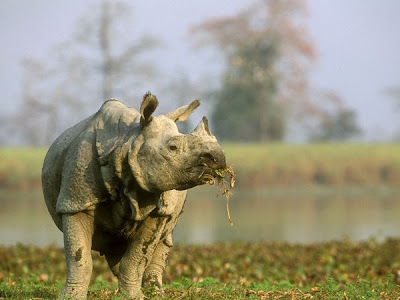The Indian rhino was once found throughout the northern sub-continent, but today about 275 rhinos survive in fragmented populations. Numbers have dropped by 70% in the past twenty years. Today it faces a particularly nefarious challenge from poachers, this has resulted in the Indian Rhino only surviving in protected parks.
The Indian rhino has one horn, which poacher's prize because they can sell it on for large sums of money. That’s because rhino horn is highly valued as a complementary medicine, especially in China, despite there being little objective evidence that it has any medicinal effect.
What does the Indian Rhino eat?
The Indian rhinos – correctly known as the great Indian one-horned rhinoceros, is a survivor from an old race of rhinoceros. Despite its fearsome appearance, it is a peaceful grazing animal, moving around to take advantage of fresh plant growth. It is adaptable in its feeding methods, extending its upper lip to grasp a bunch of long grass, or folding it away when feeding on short, newly-grown grass.
The Indian rhino also eats bamboo shoots, water hyacinths and a variety of domestic crops – which can make it a nuisance to farmers
Where does the Indian Rhino live?
Due to widespread poaching of the Indian rhino, its range has contracted eastwards – now only found in 10 locations in India and Nepal. The Indian rhino lives in the dense jungles of tall elephant grass found growing in swampy areas closed to rivers. Here, the rhino finds the wallows, or areas of shallow water and soft mud that it needs to keep cool during the heat of the day. The Indian rhino will occasionally move to higher wooded country in search for food. On such journeys, the Indian rhino will often follow the path of a rocky stream bed into the hills.
Indian rhino behaviour
The Indian rhino does not spend much time defending its territory, although males, adult females and female with calves each establish their own feeding area and sleeping space. If another animal wanders into this space then the owner will drive the intruder away. However, the Indian rhino will share ‘public places’ such as paths through the grass, bathing pools and wallows. New arrivals are challenged by those already there, answering grunt with grunt until they are permitted to join the group.
The rhino spends the afternoon in the shade, moving into its more open feeding areas at dusk to graze there until about mid-night. Females with young calves move into the shelter of tall grass in order to protect their young from tigers, while the other lie down wherever they are feeding.
Wallowing is important for rhinos as it helps to protect their skin from biting insects, keeps the skin supple, and also prevent the rhino from overheating or getting sunburned.
Throughout the day, local populations of Indian rhinos keep in contact, not only by meeting at the wallows, by also by using communal dung heaps. These dung heaps can get as large as 5 metres across and 1 metre high! Just remember to wash your hands afterwards and especially before eating.
The Indian rhino can do considerable damage to crops, able to quickly destroy a whole field of wheat or lentils. Obviously, this can make the Indian rhino very unpopular with farmers, but in turn, local farmers and villagers collect elephant grass – the rhinos main food source - to use as building material for their houses.
In Nepal, villages near national parks are allowed to collect elephant grass at certain times of the year for a small fee which can help to encourage new grass to grow. Unfortunately, no solution has been found to the problem of poachers, who kill the rhino for its horn
Breeding Indian rhinos
The female Indian rhino comes into season for 24 hours, every 5 – 8 weeks. She attracts the male by spraying urine over bushes and on the ground, and by making a gentle whistling sound.
As the time for giving birth draws nearer, the female Indian rhino moves into denser cover. The new born will weigh in at about 65 kg and in the first few weeks afterwards, the mother will produce between 20-25 litres of milk every day in order to feed it! The calf will begin to graze at two months but will continue to suckle for at least a year or until the next calf is born. The calf will stay close to her mother until she gives birth to her next offspring – usually between 18 months and two years later. It will then join an established group of rhinos, choosing and defending its own private feeding and sleeping areas.
Click here for related articles:
BLACK RHINO FACTS
THE INDIAN RHINO











No comments:
Post a Comment